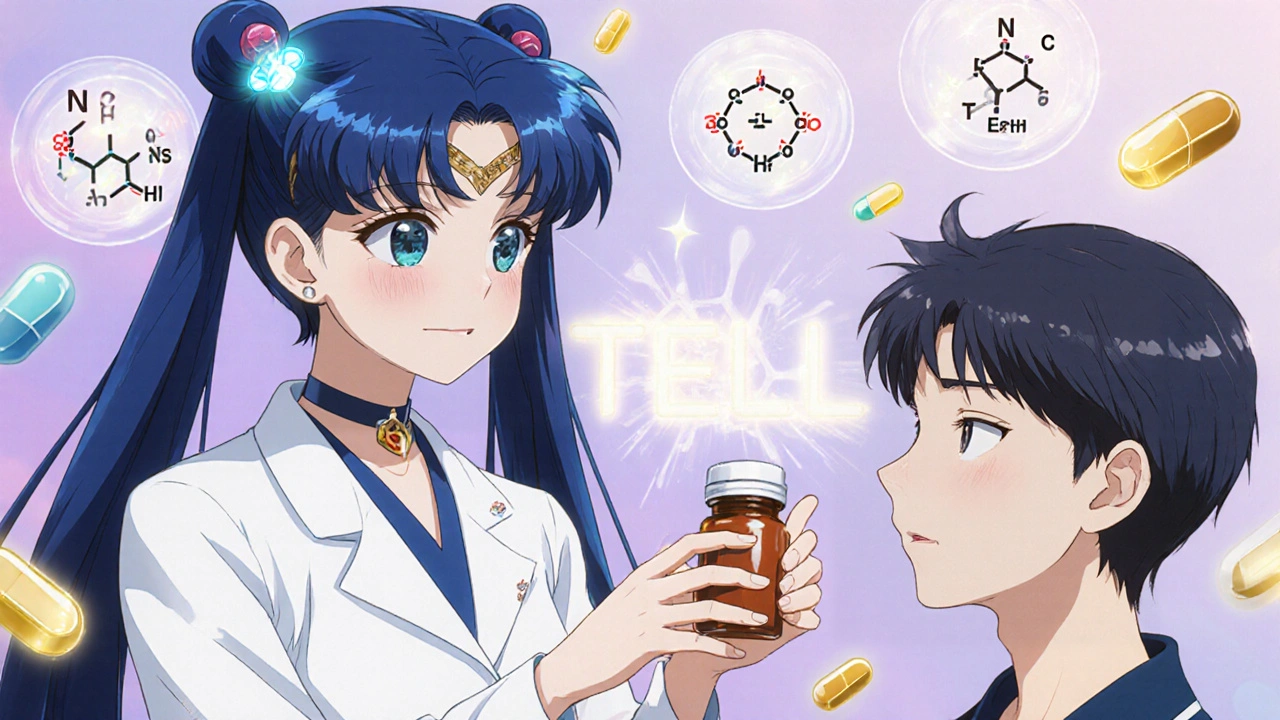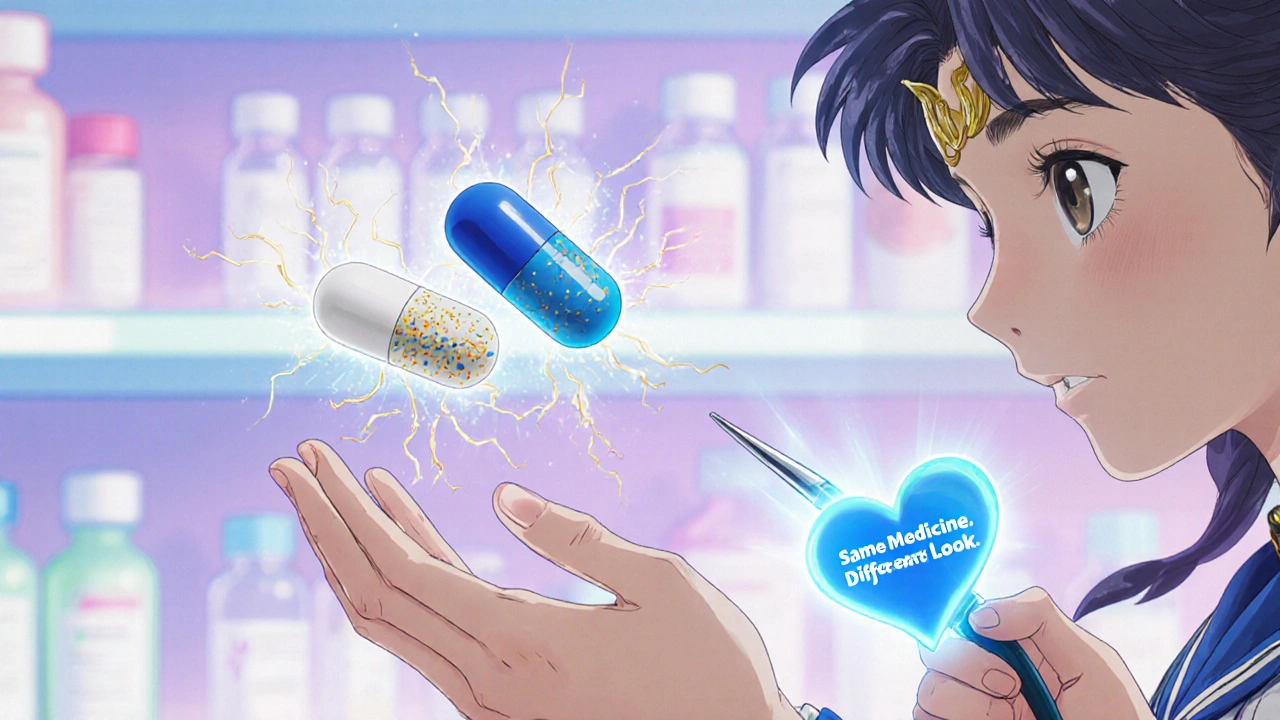How to Talk to Patients About Generic Medications Without Losing Their Trust
 Nov, 23 2025
Nov, 23 2025
When a patient picks up a prescription and sees a pill that looks nothing like the one they’ve been taking for years, their first question isn’t about cost-it’s about safety. Generic medications are just as effective as brand-name drugs, but if you don’t explain why, patients will assume the worst. They worry the new pill won’t work, or worse, that it’ll make them sick. And honestly? Those fears aren’t irrational. The color’s different. The shape’s different. Even the imprint on the pill changed. If you don’t address this head-on, you risk losing their trust-and their adherence.
Why Patients Doubt Generics (Even When They Shouldn’t)
Most patients don’t know that the FDA requires generics to have the exact same active ingredient, strength, and dosage form as the brand-name version. What they see is a different-looking pill. And when they’ve been told for years that "name brand means better," switching feels risky. A 2011 study found that 28% of patients were concerned about switching from brand to generic. Of those, 17% stopped taking the medication altogether.
It’s not just about looks. Some patients remember a bad experience-maybe a generic version gave them a headache, or they felt "off." But here’s the truth: inactive ingredients (fillers, dyes, binders) vary between manufacturers. That’s legal. That’s normal. But if you don’t explain that, patients blame the active ingredient. They think the medicine changed. It didn’t. The delivery system did.
And then there’s the cost factor. Patients who save $300 a month on a cholesterol med like rosuvastatin often don’t realize they’re getting the exact same drug. They think they’re getting a bargain basement version. You have to flip that narrative: this isn’t a discount-it’s a smart, science-backed choice.
The TELL Framework That Actually Works
There’s no one-size-fits-all script. But there’s a proven structure: TELL.
- Tell them the generic has the same active ingredient. Say it clearly: "This is the same medicine your doctor prescribed. It’s not a substitute-it’s the same thing, just made by a different company."
- Explain why it looks different. "Trademark laws don’t let generics copy the exact shape or color. That’s why your new pill is white instead of blue. But the medicine inside? Identical."
- Listen without interrupting. Let them say, "I tried this before and it didn’t work." Don’t dismiss it. Ask: "What happened when you took it?" Sometimes it’s a bad batch. Sometimes it’s a different manufacturer. Sometimes it’s anxiety. You need to know which.
- Link it to their goals. "You told me last visit you wanted to avoid hospital visits because of your blood pressure. This generic saves you $250 a month-so you can afford to refill it every month, not skip doses because it’s too expensive."
This isn’t a sales pitch. It’s a conversation. And it takes about three to five minutes. But that time pays off. Patients who get this kind of counseling are 22% more likely to stick with their meds six months later.
Common Questions-and How to Answer Them
Patients ask the same things over and over. Be ready.
- "Is this really the same medicine?" "Yes. The FDA requires it to have the same active ingredient, strength, and how fast it gets into your bloodstream. We test this before it’s sold."
- "Why does it look different?" "The brand-name company owns the design. By law, generics can’t look exactly the same. But the medicine? Same as before."
- "Is it as strong?" "The FDA requires generics to deliver the same amount of medicine into your body within the same time frame. If it didn’t meet that standard, it wouldn’t be approved."
- "I heard generics aren’t tested as well." "They’re tested differently. Brand-name drugs go through years of clinical trials. Generics use that existing data and prove they work the same way. The FDA inspects their factories too-same standards as the brand."
Don’t just answer. Use the teach-back method. Ask: "Can you tell me in your own words why this generic is safe?" If they can explain it back, they’re far more likely to take it.

When Generics Aren’t the Easy Choice
There are exceptions. For drugs with a narrow therapeutic index-like warfarin, levothyroxine, or phenytoin-small changes in blood levels can matter. The FDA requires extra scrutiny for these, and some providers prefer to stick with one manufacturer.
But here’s the catch: even for these drugs, switching between FDA-approved generics is still safe. The problem isn’t the generic. It’s switching between multiple generics. If a patient’s on a specific brand of levothyroxine and doing well, don’t switch them unless necessary. If they’re on a generic and stable? Keep them there. Don’t flip them back and forth.
And if they’ve had a bad reaction? Document it. Note the manufacturer and lot number. Sometimes it’s not the drug-it’s a bad batch. That’s rare, but it happens. You can’t assume it’s the generic’s fault.
How to Make It Stick
One conversation isn’t enough. Patients forget. That’s why documentation matters. When you talk to them about a generic, write it down. Not just "patient counseled." Write: "Explained bioequivalence. Addressed concern about color change. Patient agreed to try. Will follow up in 2 weeks."
That note becomes part of their record. Next time they see a different pharmacist? They won’t have to repeat themselves. And if they come back saying, "This new pill doesn’t work," you’ve got the history. You can say: "Last time we talked, you were worried about the color. This one’s from the same manufacturer as before. Let’s check your levels."
Training helps. Pharmacists who complete the APhA’s certification on generic communication report 65% more confidence in these talks. That confidence shows. Patients sense when you’re unsure. When you’re calm, clear, and certain-they believe you.

What’s Changing Right Now
The FDA is spending $5 million in 2025 on patient education about generics. They’re testing video tools that explain bioequivalence in simple terms. Early results? Patients who watch a 90-second video before talking to their pharmacist are 31% more likely to accept a generic.
And authorized generics-brand-name companies selling their own generic versions-are growing. If a patient refuses a generic, you can sometimes offer the authorized version. It’s made by the same company, looks the same, tastes the same. It’s still cheaper than the brand. And it’s still FDA-approved.
For complex generics-like inhalers, creams, or injectables-the science is harder. But the communication rule stays the same: explain, listen, link.
It’s Not About Saving Money. It’s About Keeping People Healthy.
Generics save the U.S. healthcare system $373 billion a year. But that number doesn’t mean much to a patient who’s scared their blood pressure med isn’t working.
What matters is this: 90% of prescriptions filled in the U.S. are generics. They’re not second-rate. They’re the standard. And if you don’t help patients understand that, you’re letting fear drive their health decisions-not science.
Every time you take five minutes to explain a generic, you’re not just filling a prescription. You’re preventing a hospital visit. You’re helping someone afford their meds next month. You’re giving them back control.
That’s not just good pharmacy. That’s good medicine.
Are generic medications really as effective as brand-name drugs?
Yes. The FDA requires generics to have the same active ingredient, strength, dosage form, and route of administration as the brand-name drug. They must also prove they deliver the same amount of medicine into the bloodstream at the same rate. This is called bioequivalence, and it’s tested before approval. Studies involving over 9,000 patients show no meaningful difference in effectiveness for most drugs, including heart medications, antidepressants, and diabetes treatments.
Why do generic pills look different from brand-name ones?
Trademark laws prevent generic manufacturers from making pills that look identical to brand-name versions. That means color, shape, and imprint can vary-even if the medicine inside is the same. These differences are in the inactive ingredients, like dyes or fillers, which don’t affect how the drug works. The FDA approves these variations as long as they don’t change safety or effectiveness.
Can switching to a generic cause side effects?
The active ingredient doesn’t change, so true side effects from the medicine itself are rare. But some patients react to different inactive ingredients-like dyes or fillers-used in a new generic. This can cause mild issues like headaches or stomach upset. If this happens, note the manufacturer and report it. You can often switch to another generic from a different company, or ask about the authorized generic (made by the original brand). Most reactions are not dangerous and go away once the body adjusts.
Are generics safe for chronic conditions like high blood pressure or diabetes?
Absolutely. Generics are widely used and recommended for chronic conditions because they improve adherence by lowering cost. Studies show patients on generic blood pressure or diabetes meds are more likely to take them regularly, leading to better long-term outcomes. The FDA applies the same strict quality controls to generics for these conditions as it does to brand-name drugs.
What should I do if a patient refuses a generic?
Don’t push. Ask why. Common reasons include past bad experiences, fear of change, or misinformation. Use the TELL framework: Tell them it’s the same medicine, Explain the appearance difference, Listen to their concerns, and Link the savings to their health goals. If they still refuse, offer the authorized generic (if available), which looks and tastes like the brand but costs less. Document the conversation and follow up in a week. Sometimes, seeing the difference in their wallet makes the difference in their mind.
Do generics have the same quality as brand-name drugs?
Yes. The FDA inspects generic manufacturing facilities using the same standards as brand-name plants. In fact, many brand-name companies make their own generics. The approval process for generics includes rigorous testing of chemistry, manufacturing, and bioequivalence. There’s no evidence that generics are produced in lower-quality facilities or under looser controls.
Is it true that generics take longer to work?
No. The FDA requires generics to be bioequivalent, meaning they enter the bloodstream at the same rate and to the same extent as the brand-name drug. If a generic took longer to work, it wouldn’t be approved. Any perceived delay is usually psychological or due to differences in inactive ingredients affecting how quickly the pill breaks down in the stomach-not the active ingredient’s absorption.
Can I switch between different generic manufacturers?
For most drugs, yes. But for medications with a narrow therapeutic index-like warfarin, levothyroxine, or certain seizure drugs-switching between multiple generics can sometimes cause small fluctuations in blood levels. It’s not dangerous, but it’s best to stick with one manufacturer once a stable dose is found. If you must switch, monitor the patient closely and check lab values if needed.

Neoma Geoghegan
November 23, 2025 AT 16:01TELL framework is everything. Tell. Explain. Listen. Link. Done. No fluff. Patients get it when you cut the jargon and speak like a human.
Bartholemy Tuite
November 24, 2025 AT 21:21man i used to work in a pharmacy in dublin and let me tell you the biggest headache was patients seeing a white pill instead of the blue one they'd been on for 12 years. theyd freak out like we swapped their heart med for rat poison. once i started using the tell framework? 90% of them chillaxed. even the ones who swore generics were 'fake medicine'. funny how a 3 minute convo beats a pamphlet any day.
Sam Jepsen
November 25, 2025 AT 03:49This is gold. I've been using the TELL method with my patients and the adherence rates have shot up. Seriously, the link step? That’s the game-changer. Connect the cost savings to their life goals-whether it’s paying for their kid’s soccer camp or not skipping meals to afford meds. That’s when it clicks.
Yvonne Franklin
November 27, 2025 AT 02:33Authorized generics are underused. If a patient refuses a generic, offer the authorized one. Same company, same look, same taste, cheaper. Works wonders. No need to argue. Just hand them the option.
Daniel Jean-Baptiste
November 27, 2025 AT 14:41really appreciate this post i used to think generics were just cheaper versions but now i see theyre the standard. the part about inactive ingredients changing and causing mild side effects was eye opening. i never realized it wasnt the medicine itself but the filler or dye. also the teach back method is genius. asking them to explain it back makes sure they really get it not just nod and smile
Ravi Kumar Gupta
November 27, 2025 AT 15:13in india we have generics everywhere and people still trust them more than brand names because they know the system works. here in the us you act like switching to generic is like trading your car for a bicycle. its the same engine. same fuel. same roads. why are you scared? the pharma companies sell fear to keep profits high. stop falling for it.
Rahul Kanakarajan
November 29, 2025 AT 01:06lol you guys act like this is some groundbreaking insight. every pharmacist knows this. the real problem? You spend 5 minutes counseling but get paid for 30 seconds. Insurance doesn't reimburse for talking. So you skip it. That's the system failing not the pharmacist. Fix the reimbursement model first. Otherwise this is just performative education.
Jessica Correa
November 30, 2025 AT 03:05I had a patient last week who refused her generic blood pressure med because it was round instead of oval. I showed her the FDA page on bioequivalence and she cried. Said she thought she was being cheated. We talked for 10 minutes. She filled it. She texted me two days later saying she felt better than she had in months. This stuff matters so much more than people realize
Holly Schumacher
December 1, 2025 AT 03:09Let’s be real-some generics DO have issues. I’ve seen patients with thyroid issues go from stable to symptomatic after switching generics. The FDA’s bioequivalence standards are too loose. 80-125% range? That’s a 45% swing. For a drug like levothyroxine, that’s dangerous. This post ignores the real clinical risks. It’s not fear-it’s science.
Michael Fitzpatrick
December 3, 2025 AT 02:09I’ve been doing this for 22 years and I can tell you the biggest thing that helps is consistency. If a patient starts on a generic from Manufacturer A, try to keep them on it. Even if another one is cheaper, switching back and forth between generics-even if they’re all FDA-approved-can mess with people’s heads. I’ve had patients say, ‘I don’t know what’s different but I feel weird.’ And nine times out of ten, it’s because the pill changed again. Stick with one. It’s not about cost anymore. It’s about peace of mind.
Shawn Daughhetee
December 4, 2025 AT 13:14my grandma took a generic for her cholesterol and said it made her dizzy. we switched back to brand and she felt fine. i thought it was just her being old but then i read this and realized maybe it was the dye. she’s allergic to red 40. never thought about that. now i always ask about allergies to colors or fillers. small thing. big difference.
Miruna Alexandru
December 5, 2025 AT 07:25It’s ironic that you call this ‘good medicine’ while simultaneously dismissing the psychological impact of pill appearance. The placebo effect isn’t a bug-it’s a feature of human physiology. If a patient believes a blue pill works better, forcing a white one on them without acknowledging that belief is not patient-centered care. It’s pharmaceutical paternalism dressed up as education. You can’t rationalize away perception. You have to honor it-even if it’s irrational.
Justin Daniel
December 6, 2025 AT 22:20lol i love how we treat this like its some new breakthrough. the tell framework? thats just good communication. and the authorized generic trick? been doing that since 2015. the real win here is that we finally have data proving what we’ve always known: people listen when you’re calm and clear. no magic. just humanity. also the FDA video thing? genius. 90 seconds beats a 10 page handout any day. someone finally gets it.